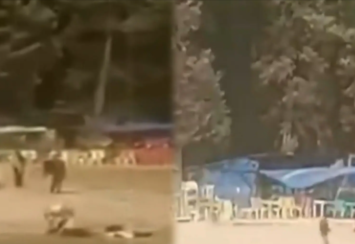New Delhi: In a major development in the Pahalgam terror attack probe, security agencies have gathered evidence, including official documents from Pakistan and biometric data, confirming that the three slain terrorists involved in the horrific incident were Pakistani nationals, officials said here Monday.
The three senior Lashkar-e-Taiba (LeT) commanders, who were killed in a July 28 encounter code-named ‘Operation Mahadev’ on the outskirts of Srinagar, had been hiding in the Dachigam-Harwan forest belt since the April 22 attack, the officials said.
The terror attack in Pahalgam’s Baisaran meadow had claimed 26 lives, mainly tourists. The officials also sought to clarify that no local youths were involved in the shooting during the attack.
The evidence collected by security agencies leaves no doubt about the terrorists’ nationality, with the Union Home Minister Amit Shah detailing key findings in Parliament.
Forensic, documentary and testimonial evidence collected during and after ‘Operation Mahadev’ conclusively shows that all three attackers were Pakistani nationals and hardcore terrorists of the banned Lashkar-e-Taiba who had been hiding in the Dachigam-Harwan forest belt since the day of the attack, the officials said.
The slain terrorists were identified as Suleman Shah alias “Faizal Jatt”, an A++ category terrorist, mastermind and lead shooter; his close associate Abu Hamza alias ‘Afghan’, an A-grade commander and the second gunman; and Yasir alias ‘Jibran’, also an A-grade commander and the third gunman, the officials said.
Biometric records of Pakistan’s National Database and Registration Authority (NADRA), voter identity slips and digital satellite phone data, including logs and GPS waypoints, are among the evidence gathered by the security agencies confirming the Pakistani nationality of the three terrorists, the officials said.
A micro-SD chip recovered from a damaged satellite phone contained Pakistan’s NADRA biometric records — including fingerprints, facial templates, and family trees — confirming their citizenship and addresses in Pakistan and Pakistan-occupied Kashmir (PoK).
The shell casings found at the Pahalgam attack site were a 100 per cent ballistic match with the three rifles seized from the terrorists after their encounter.
Pakistani-manufactured items, including wrappers for ‘CandyLand’ and ‘ChocoMax’ chocolates (brands produced in Karachi), were found in their rucksacks. The lot numbers on these wrappers were traced to a May 2024 consignment shipped to PoK.
The terrorists crossed the Line of Control (LoC) through north Kashmir’s Gurez sector in May 2022, when the intelligence intercepts placed their radio check-in from the Pakistani side, the officials said.
April 21, they moved into a ‘dhok’ (seasonal hut) at Hill Park, 2 km from Baisaran, as was stated by two detained helpers, Parvaiz and Bashir Ahmad Jothar, who sheltered them overnight and provided them cooked food before they trekked to Baisaran the next day to carry out the attack.
The GPS waypoints recovered from Shah’s Garmin device match the exact firing positions reported by eyewitnesses, the officials said, adding that they escaped towards Dachigam after carrying out the attack.
On digital footprints, they said a Huawei satellite phone (IMEI 86761204-XXXXXX) used by the terrorists had been pinging Inmarsat-4 F1 every night between April 22 and July 25. Triangulation narrowed the search grid to four square kilometres inside Harwan forest.
Jammu and Kashmir Police had released sketches of three people — Hashim Musa, Ali Bhai alias “Talha”, and local Adil Hussain Thoker — April 24.
However, after the July 28 encounter, the agencies clarified that those sketches were based on a photograph found on a phone retrieved from an unrelated December 2024 shootout and the actual attackers were different.
Another crucial evidence of Pakistan’s involvement in the attack was the command and control links inside the neighbouring country, the officials said.
They said LeT’s south-Kashmir operations chief, Sajid Saifullah Jatt of Changa Manga in Lahore, was the overall handler as his voice samples from the recovered sat-phone matched his earlier intercepted calls.
LeT Rawalakot chief Rizwan Anees also visited the families of the slain attackers July 29 to organise ‘Ghaibana Namaz-e-Janaza’ (funeral prayers in absentia) and its footage is now part of the Indian dossier, they said.
Statements from two arrested local helpers, Parvaiz and Bashir Ahmad Jothar, corroborated the terrorists’ movements and confirmed they had sheltered them before the attack.
The Union Home Minister, immediately after the ‘Operation Mahadev’, gave a statement that the intelligence trail for the terrorists began with a “human intelligence” alert leading to a meticulous tracking operation. The operation was spearheaded by the Army’s elite ‘Para 4’ unit, working alongside the CRPF and the Jammu and Kashmir Police.
To confirm the ballistic evidence, the rifles were flown to Chandigarh on a special flight, the Home Minister said, adding six forensic scientists confirmed the 100 per cent match via video call just hours later, underscoring the urgency and precision of the investigation.
The Home Minister’s speech also unveiled the details of ‘Operation Sindoor,’ a retaliatory strike carried out inside Pakistan in response to the Pahalgam attack.
The investigation into the Pahalgam attack, handled by the NIA, was massive in scale, involving statements from over 1,055 people and more than 3,000 hours of interrogation.
PTI
